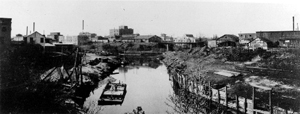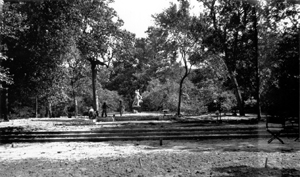|
|
|
|
In 1836 Augustus and John Allen established a small settlement along a muddy and mosquito-infested area of the Buffalo Bayou. They named the town after Sam Houston, who had won independence for Texas at the Battle of San Jacinto earlier that year. Houston prospered, and in 1914 the winding bayou was converted into a shipping channel, fueling the city's growth as a center for timber, cotton, and cattle shipping. |
|
| As the twentieth century unfolded, an oil boom assured Houston's future as a world energy center. |
 |
|
Buffalo
Bayou at Houston in 1904
© Houston Metropolitan Research Center Houston Public Library |
|
| By the 1920s Houston was experiencing many of the problems faced by other cities across the nation. Many of its leading citizens joined forces to control growth and to formulate ideas for planning and beautification. Although many of their proposals were never realized, the city benefited immeasurably from these efforts. Among Houston's most civic-minded citizens was Will Hogg, who gave his own land to the city to create Memorial Park and other public green spaces. |
|
Will Hogg's commitment to urban planning was matched by an entrepreneurial spirit. In 1924, together with his brother Mike and their associate Hugh Potter, he began planning a lush subdivision that would allow Houstonians to escape from the noise, dirt, and congestion of the city. River Oaks, as the new suburb was named, was built upon 1100 acres of open farmland and rustic woodlands three miles west of downtown Houston. Advertised as a "distinguished experiment in fine living," it became a national model for community planning. |
|
|
River
Oaks in 1923
© Houston Metropolitan Research Center Houston Public Library |
| One 80-acre area in the heart of River Oaks, Houston's most elegant residential area, was set aside as a separate subdivision called Homewoods. This enclave contained just fourteen lots, the largest of which was reserved by the Hoggs and would become Bayou Bend. |
| In 1920 Miss Hogg had begun assembling an important collection of American decorative arts. To provide suitable settings for these extraordinary antiques, Staub designed simple but stately interiors in the style of colonial American rooms. In Miss Hogg's bedroom and sitting room, he incorporated floorboards and paneling rescued from two eighteenth-century Massachusetts houses. |
 |
The gardens presented a special challenge. Covered in towering trees and thick undergrowth, the site was, in Miss Hogg's words, "nothing but a dense thicket." Undaunted, she created a series of gracious and beautiful gardens that were intended as outdoor rooms for living and entertaining, not just views to be admired from within the house. But Miss Hogg was also appreciative of the wilder side of nature, and she always intended that the surrounding woodlands, remain more or less natural, as they are today. | |
|
Above:
At
Right: |
 |
|
The Hoggs shared Bayou Bend for only a brief time. Mike Hogg married and moved away in 1929; Will Hogg died the following year, leaving his sister as sole occupant of the house. Miss Hogg donated Bayou Bend to the Museum of Fine Arts, Houston, in 1957, but continued living at the estate until 1965. She oversaw the transformation of her home into a house museum, which opened to the public in 1966. Today, Bayou Bend remains one of Houston's cultural treasures. |
![]()
Welcome
| History | Staff | Credits
Home | About Bayou Bend
| Information | Collection
| Gardens | Miss
Hogg | Education | Site
Map
Copyright © 2001 Museum of Fine Arts, Houston. All rights reserved.